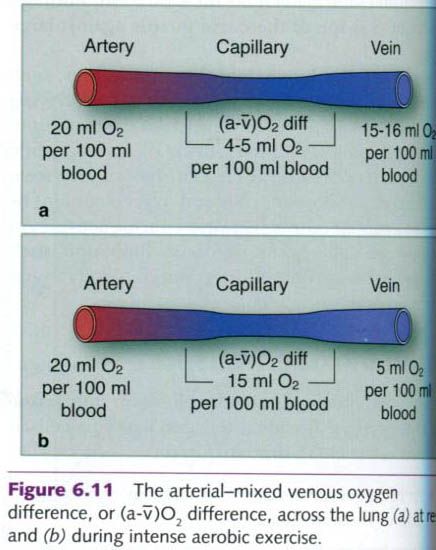At rest, the oxygen content of arterial blood
is about 20ml of oxygen per 100ml of blood. As shown in the figure a below,
this value decreases to 15 to 16ml of oxygen per 100ml after the blood has
passed through the capillaries into the venous system. This difference in
oxygen content between arterial and venous blood is referred to as the arterial-mixed venous oxygen
difference, or (a-ṽ difference) O2 difference. The term mixed
venous(ṽ) refers to the oxygen content of blood in the right atrium, which
comes from all parts of the body, both active and inactive. The difference
between arterial and mixed venous oxygen content reflects to the 4 to 5ml of
oxygen per 100ml of blood taken up by the tissues. The amount of oxygen taken
up is proportional to its use for oxidative energy production. Thus, as the
rate of oxygen use increases, the (a-ṽ) O2 difference also
increases. It can increase to 15 to 16ml per 100ml of blood during maximal
levels of endurance exercise(figure b). However, at the level of the
contracting muscle, the (a-ṽ) O2
difference during intense exercise can increase to 17 to 18ml per 100ml of
blood. Note that there is not a bar over the v in this instance because we are
now looking at local muscle venous blood, not mixed venous blood in the right
atrium. During such an effort, more oxygen is unloaded to the active muscles
because the PO2 in the muscles is substantially lower than in
arterial blood.
Oxygen transport in the muscle
Oxygen is transported in the muscle to the
mitochondria by a molecule called myoglobin where it is used in oxidative
metabolism. Myoglobin is similar in
structure to hemoglobin, but myoglobin has a much greater affinity for oxygen
than hemoglobin. This concept is illustrated in the figure below. At PO2
values less than 20, the myoglobin dissociation curve is much steeper than the
dissociation curve for hemoglobin. Myoglobin releases its oxygen content only
under conditions in which the PO2 is very low. Note from the figure
below that at a PO2 at which venous blood is unloading oxygen,
myoglobin is loading oxygen. It is estimated that the PO2 in the
mitochondria of an exercising muscle may be as low as 1 to 2 mmHg; thus
myoglobin readily delivers oxygen to the mitochondria.
Factors influencing oxygen delivery and uptake
The rates of oxygen delivery and uptake depend
on three major variables:
- Oxygen content of blood
- Blood flow
- Local conditions(e.g., pH,
temperature).
With exercise, each of these variables is
adjusted to ensure increased oxygen delivery to active muscle. Under normal
circumstances, hemoglobin is about 98% saturated with oxygen. Any reduction in
the blood’s normal oxygen-carrying capacity would hinder oxygen delivery and
reduce cellular uptake of oxygen. Likewise, a reduction in the PO2 of the
arterial blood would lower the partial pressure gradient, limiting the
unloading of oxygen at the tissue level. Exercise increases blood flow through
the muscles, less oxygen must be removed from each 100ml of blood(assuming the
demand is unchanged). Thus, increased blood flow improves oxygen delivery.
Many local changes in the muscle during
exercise affect oxygen delivery and uptake. For example, muscle activity
increases muscle acidity because lactate production. Also, muscle temperature
and carbon dioxide concentration both increase because of increased metabolism.
All these changes increase oxygen unloading from the hemoglobin molecule,
facilitating oxygen unloading from the hemoglobin molecule, facilitating oxygen
delivery and uptake by the muscles.
Carbon dioxide removal
Carbon
dioxide exits the cells by simple diffusion in response to the partial pressure
gradient between the tissue and the capillary blood. For example, muscles generate carbon dioxide
through oxidative metabolism, so the PCO2 in muscles is relatively
high compared with that in the capillary blood. Consequently, CO2
diffuses out of the muscles and into the blood to be transported to the lungs.











0 коментара:
Постави коментар